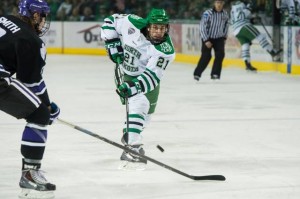Since National Collegiate Hockey Conference has been in existence, the league has been very proactive in making sure the college hockey fan comes first.
The NCHC is on the forefront for engaging their fans through social media. In the past, the league has solicited feedback from the fans on how to improve the college hockey experience.

The NCHC has also been on the cutting edge when it comes to the on-ice competition, too.
This season, the NCHC will become the first Division 1 college hockey conference to adopt the 3-on-3 overtime format. Like the NHL and the AHL, the NCHC wants to make sure that fewer games are decided by the shootout.
As has been the case in previous seasons, any conference game that remains tied after regulation will play the NCAA-mandated 5-on-5 (plus goalies) 5-minute overtime period, which is also done throughout all NCAA hockey conferences. If one team scores, they receive all three points in the conference standings while the losing team receives none. The game also counts as a win and loss nationally in the PairWise rankings. If no goal is scored, the game is considered a tie with both teams receiving one point in the conference standings and it is also called a tie nationally, also the same as previous seasons.
Beginning in October, if a conference game is still tied after the 5-minute overtime, the two teams will then play a 3-on-3 (plus goalies) 5-minute overtime period for the extra point in the conference standings, keeping all conference games worth three points. The result of the 3-on-3 overtime will not affect the PairWise rankings as the game is still considered a tie. If a team scores during the 3-on-3 overtime, the winning team will receive the extra point for two points in the standings while the losing team will receive the one point for the tie. The final score of the game will still reflect a tie, however.
If the game is tied after the 3-on-3 overtime, the teams will play sudden death shootout for the extra point.
Will the Other Leagues Follow Suit?
Since college hockey is a major development route to the NHL, it makes perfect sense for NCHC to adopt the 3-on-3 overtime format. Hopefully, the other college hockey leagues should adopt this overtime format, too.
It will be interesting to see if the other Division 1 college hockey leagues will follow suit and decide to use the 3-on-3 overtime format. The last two seasons, the NCHC and the Big Ten Hockey Conference were the only conferences to use the shootout to break ties during league play.
Of course, the hockey purists will say that the 3-on-3 overtime format cheapens the game and is a gimmick. Some fans will call it a sideshow. This is the same argument that was given when hockey leagues adopted the shootout. With time, the fans will probably embrace the 3-on-3 format. I think the NCHC should be applauded for moving forward and making this happen.
It would appear that the UND coaching staff is on board with the new rule change.
“It helps to have an outcome, UND assistant coach Matt Shaw said. “I mean, fans and everybody, coaches and players wants an outcome of the game. They don’t want ties. There’re a lot of hockey purists out there in the hockey community that don’t really like the shootout as a way to end a game. I do think it’s important to have some sort of result as opposed to a tie.”